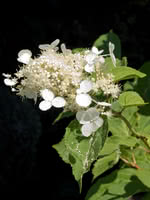Mon-Fri 9am - 5pm Mountain time
Panicle Hydrangea vs Nodding Onion
Allium cernuum
Hydrangea paniculata
NOT AVAILABLE THIS SEASON - MIGHT RETURN
CUSTOM GROW
Nodding Onion is a native perennial wildflower known for its nodding clusters of flowers that range in color from white to pink to purple. The lightly scented blooms provide pollen and nectar for pollinators, especially bees, which can collect while hanging upside down, a capability most other insects lack.
The narrow, grass-like leaves of the Nodding Onion can be used as a seasoning in cooked dishes, though bulbs and raw leaves should not be eaten in large quantities. All parts of the plant have an onion-like aroma when bruised, which helps deter deer and rabbits. They can self-seed readily, so removing spent blooms helps manage their spread. Tolerant of a range of soils, including alkaline, it is well-suited for a variety of plantings, including pollinator gardens and naturalization projects.
Panicle Hydrangea is a large, broad-leaf, deciduous shrub that is prized for its ornamental appeal. It is easy to care for, long-lived, and cold-hardy.
Depending on the variety, its flowers change color throughout the blooming period. Make sure you water Panicle Hydrangeas regularly to achieve the most notable color change.
Nodding Onion Quick Facts
Panicle Hydrangea Quick Facts
Toxicity: raw leaves and bulbs can be midly toxic

